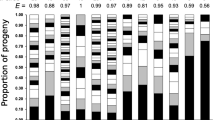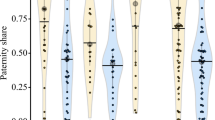Abstract
Seabirds are long-lived birds that invest in offspring at very high levels, for which male parental care is indispensable. These characteristics are thought to explain seabirds’ generally low level of extra-pair paternity (EPP). Although the Streaked Shearwater (Calonectris leucomelas) is a socially monogamous seabird, it is known to copulate outside its social pair bond, which implies the frequent occurrence of EPP. In the closely related Cory’s Shearwater Calonectris borealis, cuckoldry is related to body size of the social male. To determine whether body-size-related EPP occurs among Streaked Shearwaters, we established 39 new microsatellite markers for parentage analysis and compared body size between cuckolded and non-cuckolded males. With the new markers, we found that extra-pair males sired 17 (15.0%) of 113 offspring during the 2014–2016 study period, which included three 1.5-month chick-rearing periods. This percentage is among the highest recorded for seabirds. We also found the bill and wing length of cuckolded males to be significantly shorter than those of non-cuckolded males, and that females can reject attempted copulations. These observations imply that EPP in this species is size related and involves female acceptance.
Zusammenfassung
Fremdvaterschaft bei sozial monogamen Weißgesicht-Sturmtauchern: erzwungene Kopulation oder weibliche Aufforderung?
Seevögel gehören zu den langlebigen Vogelarten, welche in hohem Maße in ihre Nachkommen investieren, was eine väterliche Fürsorge unerlässlich macht. Diese Eigenschaften sollen den generell geringen Grad an Fremdvaterschaften (engl. extra-pair paternity, EPP) bei diesen Vögeln erklären. Obwohl der Weißgesicht-Sturmtaucher (Calonectris leucomelas) zu den sozial monogamen Seevögeln gehört, sind bei dieser Art Kopulationen außerhalb des sozialen Paarbundes bekannt, was ein häufiges Auftreten von EPP nahelegt. Beim nahverwandten Gelbschnabel-Sturmtaucher Calonectris borealis hängt das Fremdgehen mit der Körpergröße des sozialen Männchens zusammen. Um festzustellen, ob eine körpergrößenbezogene EPP beim Weißgesicht-Sturmtaucher vorkommt, haben wir 39 neue Mikrosatellitenmarker für die Vaterschaftsanalyse etabliert und die Körpergröße zwischen „betrogenen“und „nicht betrogenen“Männchen verglichen. Mit den neuen Markern konnten wir zeigen, dass Männchen außerhalb des Paarbundes 17 (15,0%) von 113 Nachkommen während des Untersuchungszeitraumes 2014-2016 zeugten. Der Untersuchungszeitraum umfasste drei Jungaufzuchten von jeweils 1,5 Monaten. Dieser prozentuale Anteil gehört zu den größten, die bislang bei Seevögeln ermittelt wurden. Weiterhin haben wir festgestellt, dass Schnabel- und Flügellänge der „betrogenen“Männchen signifikant kürzer als bei den „nicht betrogenen“Männchen waren. Zudem zeigte sich, dass Weibchen Kopulationsversuche abwehren können. Unsere Beobachtungen lassen bei dieser Art eine größenbezogene EPP vermuten, bei der die Akzeptanz des Weibchens erforderlich ist.

Similar content being viewed by others
References
Andrew D, Douglas R, Sean LCO, Terry B (1994) Parental investment inversely related to degree of extra-pair paternity in the Reed Bunting. Nature 371:698–700
Arima H, Sugawa H (2004) Correlation between the pitch of calls and external measurements of Streaked Shearwaters Calonectris leucomelas breeding on Kanmuri Island. Jpn J Ornithol 53:40–44
Arima H, Oka N, Baba Y, Sugawa H, Ota T (2014) Gender identification by calls and body size of the Streaked Shearwater examined by CHD genes. Ornithol Sci 13:9–17
Blacket MJ, Robin C, Good RT, Lee SF, Miller AD (2012) Universal primers for fluorescent labelling of PCR fragments—an efficient and cost-effective approach to genotyping by fluorescence. Mol Ecol Resour 12:456–463
Botstein D, White RL, Skolnick M, Davis RW (1980) Construction of a genetic linkage map in man using restriction fragment length polymorphisms. Am J Hum Genet 32:314–331
Bried J, Dubois MP, Jarne P, Jouventin P, Santos RS (2010) Does competition for nests affect genetic monogamy in Cory’s Shearwater Calonectris diomedea? J Avian Biol 41:407–418
Cornwallis CK, West SA, Davis KE, Griffin AS (2010) Promiscuity and the evolutionary transition to complex societies. Nature 466:969–972
Einoder LD, Page B, Goldsworthy SD (2008) Sexual size dimorphism and assortative mating in the Short-tailed Shearwater Puffinus tenurostiris. Mar Ornithol 36:167–173
Forstmeier W, Nakagawa S, Griffith SC, Kempenaers B (2014) Female extra-pair mating: adaptation or genetic constraint? Trends Ecol Evol 29:456–464
Gilbert L, Burke T, Krupa A (1998) No evidence for extra-pair paternity in the Western Gull. Mol Ecol 7:1549–1552
Griffith SC, Owens IPF, Thuman KA (2002) Extra pair paternity in birds: a review of interspecific variation and adaptive function. Mol Ecol 11:2195–2212
Hoi-Leitner M, Hoi H, Romero-Pujante M, Valera F (1999) Female extra–pair behaviour and environmental quality in the Serin (Serinus serinus): a test of the ‘constrained female hypothesis’. Proc R Soc Lond B 266:1021–1026
Hsu YH, Schroeder J, Winney I, Burke T, Nakagawa S (2015) Are extra-pair males different from cuckolded males? A case study and a meta-analytic examination. Mol Ecol 24:1558–1571
Hutchinson JMC, Griffith SC (2008) Extra-pair paternity in the Skylark Alauda arvensis. Ibis 150:90–97
Jouventin P, Bried J (2001) The effect of mate choice on speciation in Snow Petrels. Anim Behav 62:123–132
Jouventin P, Charmantier A, Dubois MP, Phillipe J, Bried J (2007) Extra-pair paternity in the strongly monogamous Wandering Albatross Diomedea exulans has no apparent benefits for females. Ibis 149:67–78
Kempenaers B, Verheyen GR, Dhondt AA (1997) Extrapair paternity in the Blue Tit Parus caeruleus: female choice, male characteristics, and offspring quality. Behav Ecol 8:481–492
Marshall TC, Slate J, Kruuk LEB, Pemberton JM (1998) Statistical confidence for likelihood-based paternity inference in natural populations. Mol Ecol 7:639–655
Nava CP, Kim SY, Magalhaes MC, Neves V (2014) Do Cory’s Shearwaters Calonectris borealis choose mates based on size? J Ornithol 155:869–875
Navarro J, Kaliontzopoulou A, González-Solís J (2009) Sexual dimorphism in bill morphology and feeding ecology in Cory’s Shearwater (Calonectris diomedea). Zoology 112:128–138
Oka N (2004) The distribution of Streaked Shearwater colonies, with special attention to population size, area of sea where located and surface water temperature. J Yamashina Inst Orinthol 35:164–188
Petrie M, Kempenaers B (1998) Extra-pair paternity in birds: explaining variation between species and populations. Trends Ecol Evol 13:52–57
Quillfeldt P, Schmoll T, Peter HU, Epplen JT, Lubjuhn T (2001) Genetic monogamy in Wilson’s Storm-petrel. Auk 118(1):242–248
Quillfeldt P, Masello JF, Segelbacher G (2011) Extra-pair paternity in seabirds: a review and case study of Thin-billed Prions Pachyptila belcheri. J Ornithol 153:367–373
Rabouam C, Bretagnolle V, Bigot Y, Periquet G (2000) Genetic relationships of Cory’s Shearwater: parentage, mating assortment, and geographic differentiation revealed by DNA fingerprinting. Auk 117:651–662
Raymond M, Rousset F (1995) GENEPOP (version 1.2): population genetics software for exact tests and ecumenicism. J Hered 86:248–249
Rice WR (1989) Analyzing tables of statistical tests. Evolution 43:223–225
Rousset F (2008) GENEPOP’007: a complete re-implementation of the GENEPOP software for Windows and Linux. Mol Ecol Resour 8:103–106
Shirai M, Niizuma Y, Tsuchiya K, Yamamoto M, Oka N (2013) Sexual size dimorphism in Streaked Shearwaters Calonectris leucomelas. Ornithol Sci 12:57–62
Swatschek I, Ristow D, Wink M (1994) Mate fidelity and parentage in Cory’s Shearwater Calonectris diomedea—field studies and DNA fingerprinting. Mol Ecol 3:259–262
Székely T, Reynolds JD, Figuerola J (2000) Sexual size dimorphism in shorebirds, gulls, and alcids: the influence of sexual and natural selection. Evolution 54:1404–1413
Takeshima H, Muto N, Sakai Y, Ishiguro N, Iguchi K, Ishikawa S, Nishida M (2017) Rapid and effective isolation of candidate sequences for development of microsatellite markers in 30 fish species by using kit-based target capture and multiplexed parallel sequencing. Conserv Genet Resour 9:479–490
Trivers R (1972) Parental investment and sexual selection. In: Campbell B (ed) Sexual selection and the descent of man 1871–1971. Aldine, Chicago, pp 139–179
van Oosterhout C, Hutchinson WF, Wills DPM, Shipley P (2004) Micro-Checker: software for identifying and correcting genotyping errors in microsatellite data. Mol Ecol Notes 4:535–538
Verboven N, Mateman AC (1997) Low frequency of extra-pair fertilizations in the Great Tit Parus major revealed by DNA fingerprinting. J Avian Biol 28:231–239
Westneat DF, Stewart IRK (2003) Extra-pair paternity in birds: causes, correlates, and conflict. Annu Rev Ecol Evol Syst 34:365–396
Wink M, Dyrcz A (1999) Mating system in birds: a review of molecular studies. Acta Ornithol 34:91–109
Wojczulanis-Jakubas K, Drobniak SM, Jakubas D, Kulpińska-Chamera M, Chaste O (2018) Assortative mating patterns of multiple phenotypic traits in a long-lived seabird. Ibis 160:464–469
Yamamoto T, Takahashi A, Oka N, Iida T, Katsumata N, Sato K, Trathan PN (2011) Foraging areas of Streaked Shearwaters in relation to seasonal changes in the marine environment of the northwestern Pacific: inter-colony and sex-related differences. Mar Ecol Prog Ser 424:191–204
Yoshida N (1981) Climbing the trees-Streaked Shearwaters with interesting behavior (Kini noboruumidori–Kichoohmizunagidori). Yubun, Tokyo (in Japanese)
Acknowledgments
We thank Yoshinari Yonehara, Yusuke Goto, Tatsuya Shiozaki, and Takanori Sugahara for assisting with fieldwork on Funakoshi-Ohshima Island. We are grateful to Aran Garrod, Bart Kempenaers, and an anonymous referee for insightful comments that improved the manuscript. This study was supported by grants from research fellowships of the Japan Society for the Promotion of Science for Young Scientists to Miho Sakao, Tohoku Ecosystem-Associated Marine Sciences, the Bio-logging Science Program of the University of Tokyo, National Geographic (Asia 45-16), Japan Science Technology Agency Core Research for Evolutional Science and Technology (JPMJCR1685), the Cooperative Program of the Atmosphere and Ocean Research Institute, the University of Tokyo, and the Japan Society for the Promotion of Science and OP under the Japan-UK Research Cooperative Program. The authors declare no conflict of interest.
Author information
Authors and Affiliations
Corresponding author
Ethics declarations
All procedures performed in this study involving animals were approved by the Animal Experimental Committee of the University of Tokyo and conducted in accordance with the Guidelines for the Care of Experimental Animals. This work was conducted with permission from the Ministry of the Environment and Agency for Cultural Affairs, Japan.
Additional information
Communicated by M. Wink.
Electronic supplementary material
Below is the link to the electronic supplementary material.
10336_2018_1587_MOESM3_ESM.eps
Fig. S1 Presence (n = 8) and absence (n=28) of extra-pair chicks in relation to the social female’s bill length (a), head length (b), tarsus length (c), wing length (d), and bill depth (e). Box plots show the median value, range, 25th and 75th percentiles, and outliers. P- and U-values were obtained by Mann–Whitney U-test. Supplementary material 3 (EPS 600 kb)
Supplementary material 4 (MP4 29424 kb)
Supplementary material 5 (MP4 20865 kb)
Rights and permissions
About this article
Cite this article
Sakao, M., Takeshima, H., Inoue, K. et al. Extra-pair paternity in socially monogamous Streaked Shearwaters: forced copulation or female solicitation?. J Ornithol 160, 137–144 (2019). https://doi.org/10.1007/s10336-018-1587-3
Received:
Revised:
Accepted:
Published:
Issue Date:
DOI: https://doi.org/10.1007/s10336-018-1587-3





